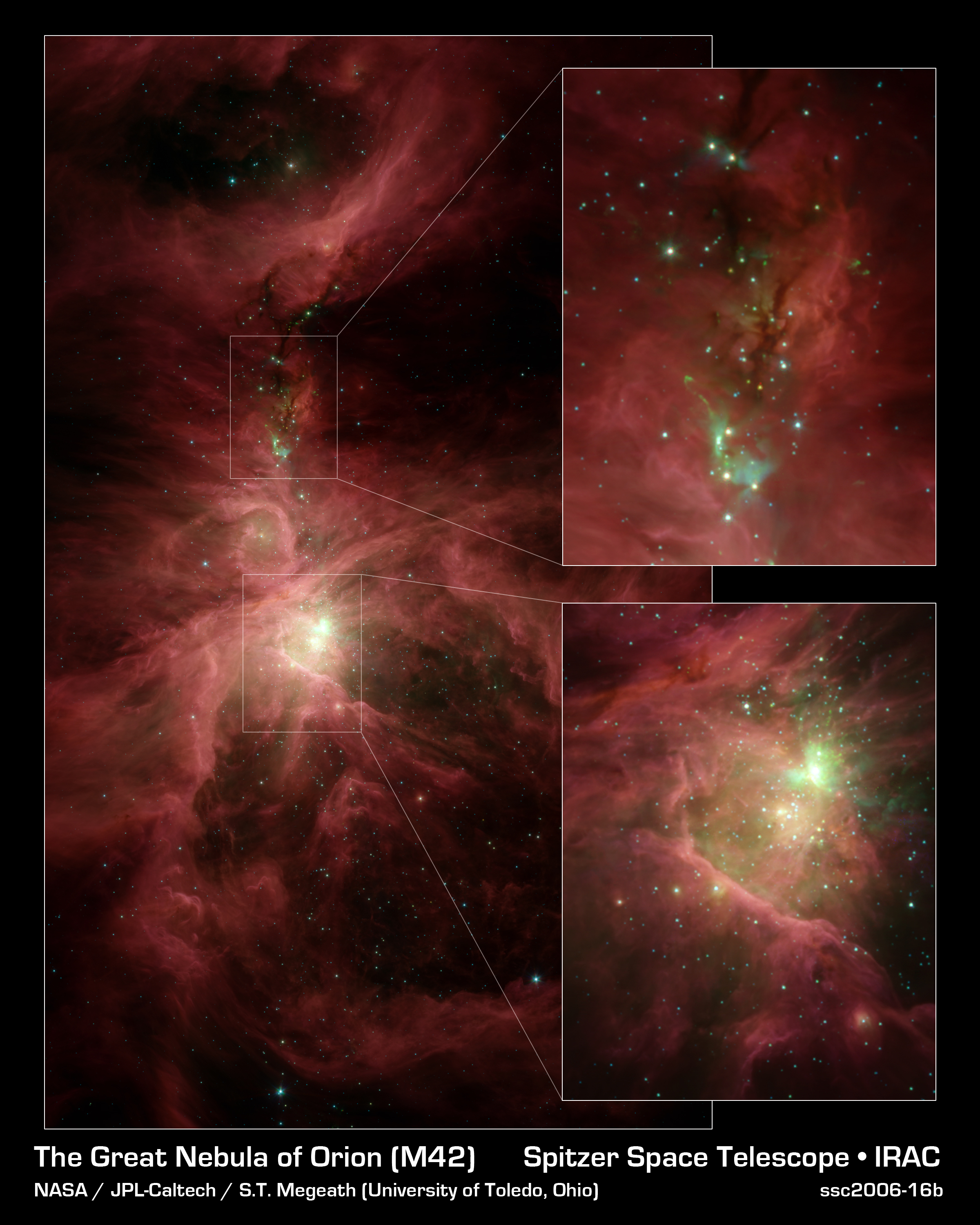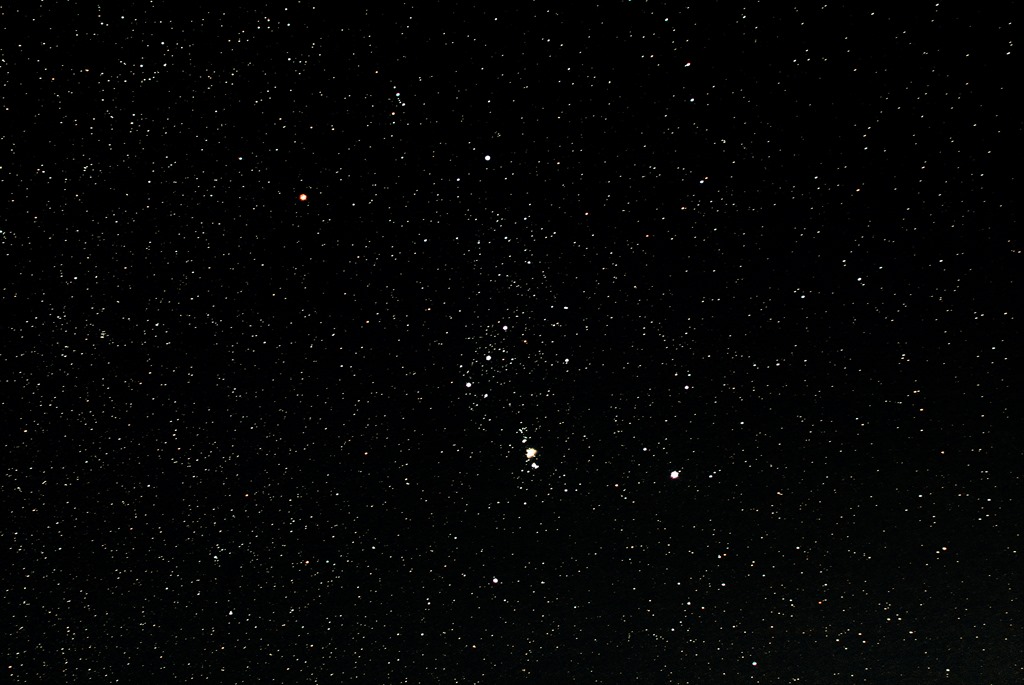Orion's Sword on:
[Wikipedia]
[Google]
[Amazon]
Orion's Sword is a compact asterism in the constellation Orion. It comprises three stars (

 !
! !
!
42 Orionis
42 Orionis is a class B1V (blue main-sequence) star in the constellation Orion. Its apparent magnitude is 4.59 and it is approximately 900 light years away based on parallax.
The primary star, Aa, has one spectroscopic companion Ab of ...
, Theta Orionis, and Iota Orionis) and M42, the Orion Nebula, which together are thought to resemble a sword or its scabbard
A scabbard is a sheath for holding a sword, knife, or other large blade. As well, rifles may be stored in a scabbard by horse riders. Military cavalry and cowboys had scabbards for their saddle ring carbine rifles and lever-action rifles on the ...
. This group is south of the prominent asterism, Orion's Belt
Orion's Belt or the Belt of Orion, also known as the Three Kings or Three Sisters, is an asterism in the constellation Orion. It consists of the three bright stars Alnitak, Alnilam and Mintaka.
Looking for Orion's Belt is the easiest way to ...
. Fables and old beliefs are in Europe dominated or widely influenced by those of the Greco-Roman narratives. Beyond Europe this grouping is quite widely referenced as a weapon just as the majority of cultures perceived Orion's standout asymmetrical "hourglass" of seven very bright stars as a human.

Components

Orion Nebula
The Orion Nebula consists of one of the nearest (thus in theMilky Way Galaxy
The Milky Way is the galaxy that includes our Solar System, with the name describing the galaxy's appearance from Earth: a hazy band of light seen in the night sky formed from stars that cannot be individually distinguished by the naked eye. ...
), massive molecular cloud
A molecular cloud, sometimes called a stellar nursery (if star formation is occurring within), is a type of interstellar cloud, the density and size of which permit absorption nebulae, the formation of molecules (most commonly molecular hydroge ...
s (30 - 40 light years in diameter) about 1,300 light years from the solar system. This makes the nebula potentially the closest HII region
An H II region or HII region is a region of interstellar atomic hydrogen that is ionized. It is typically in a molecular cloud of partially ionized gas in which star formation has recently taken place, with a size ranging from one to hundre ...
to Earth, a mass of hydrogen that has been ionized by nearby, hot, young stars. Regions like this are called stellar nurseries, nurturing the birth of multiple young stars such as the Orion Nebula Star Cluster. These are a hallmark of the asterism.
Main stars
''42 Orionis
42 Orionis is a class B1V (blue main-sequence) star in the constellation Orion. Its apparent magnitude is 4.59 and it is approximately 900 light years away based on parallax.
The primary star, Aa, has one spectroscopic companion Ab of ...
,'' also called c Ori, is a B1V magnitude star in the northern half of the Orion nebula. '' Theta Orionis'' has a more central position in the nebula, and is actually composed of a multi-star system. '' Iota Orionis'' is one of the brightest in the collection, in the south of the Orion nebula. ''Iota Orionis'' is a spectroscopic binary system, with a variable magnitude of O9III.
Scientific studies
Given the scientific significance of M42, Orion's Sword is a popular spot for stellar and protostellar studies. Using theHubble Space Telescope
The Hubble Space Telescope (often referred to as HST or Hubble) is a space telescope that was launched into low Earth orbit in 1990 and remains in operation. It was not the first space telescope, but it is one of the largest and most vers ...
, O'dell et al. focused on identifying previously unseen features of the nebula, such as high-ionization shocks, compact sources, and protoplanetary disk
A protoplanetary disk is a rotating circumstellar disc of dense gas and dust surrounding a young newly formed star, a T Tauri star, or Herbig Ae/Be star. The protoplanetary disk may also be considered an accretion disk for the star itself, be ...
s. Some studies have focused on the sword region overall. Gomez & Leda found that less than half of the OB and Hα stars in this region are associated with well-defined stellar clusters. This positional similarity, as well as the high star formation rates and gas pressure in the nearby molecular cloud, confirms the previous notion that old, foreground OB stars triggered star formation in this cloud.
References in history and culture
In his '' De Astronomia'',Hyginus
Gaius Julius Hyginus (; 64 BC – AD 17) was a Latin author, a pupil of the scholar Alexander Polyhistor, and a freedman of Caesar Augustus. He was elected superintendent of the Palatine library by Augustus according to Suetonius' ''De Grammati ...
describes the constellation Orion having three faint stars where the sword is depicted. Aratus
Aratus (; grc-gre, Ἄρατος ὁ Σολεύς; c. 315 BC/310 BC240) was a Greek didactic poet. His major extant work is his hexameter poem ''Phenomena'' ( grc-gre, Φαινόμενα, ''Phainómena'', "Appearances"; la, Phaenomena), the ...
goes into significant detail about the Orion constellation as well, proclaiming: "Should anyone fail to catch sight of him (Orion) up in the heavens on a clear night, he should not expect to behold anything more splendid when he gazes up at the sky." Cicero
Marcus Tullius Cicero ( ; ; 3 January 106 BC – 7 December 43 BC) was a Roman statesman, lawyer, scholar, philosopher, and academic skeptic, who tried to uphold optimate principles during the political crises that led to the esta ...
and Germanicus, the translators of Aratus's ''Phaenomena'', expressed it as , Latin
Latin (, or , ) is a classical language belonging to the Italic branch of the Indo-European languages. Latin was originally a dialect spoken in the lower Tiber area (then known as Latium) around present-day Rome, but through the power of the ...
for "sword". Arabic astronomers also saw this asterism as a sword ( ), calling it , Sword of the Powerful One or Sword of the Giant. Orion is one of the few constellations to have parallel identities in European and Chinese culture, given the name ''Shen'', the hunter and warrior. Chinese astronomers made the sword a sub-constellation within ''Shen'' called ''Fa''.
In the myths of the Nama of Namibia and the western Cape, this was the arrow of the husband of the Pleiades
The Pleiades (), also known as The Seven Sisters, Messier 45 and other names by different cultures, is an asterism and an open star cluster containing middle-aged, hot B-type stars in the north-west of the constellation Taurus. At a distance ...
, daughters of the sky god, who was represented by Orion's SW main star Rigel
Rigel is a blue supergiant star in the constellation of Orion. It has the Bayer designation β Orionis, which is Latinized to Beta Orionis and abbreviated Beta Ori or β Ori. Rigel is the brightest and most massive componentand ...
. When he fired his arrow at three zebras (Orion's belt) and missed, he was too afraid to retrieve the arrow due to its proximity to a fierce lion, represented by Betelgeuse. Therefore, he sits in the cold, suffering from hunger but too ashamed to return home. Regionally the prevailing cold breezes and currents come from that direction. The Tswana
Tswana may refer to:
* Tswana people, the Bantu speaking people in Botswana, South Africa, Namibia, Zimbabwe, Zambia, and other Southern Africa regions
* Tswana language, the language spoken by the (Ba)Tswana people
* Bophuthatswana, the former ba ...
to the east traditionally call the unusually bright nebula and its companions , three dogs which chase the three pigs (the belt). This serves as an etiological myth for why pigs have their litters in the same season Orion is prominent in the sky.
Orion's sword is referenced in the song "The Dark of the Sun" by Tom Petty
Thomas Earl Petty (October 20, 1950October 2, 2017) was an American musician who was the lead vocalist and guitarist of the rock band Tom Petty and the Heartbreakers, formed in 1976. He previously led the band Mudcrutch, was a member of the la ...
on his 1991 album '' Into the Great Wide Open'', in the line "saw you sail across a river underneath Orion's sword...". It is also mentioned in Jethro Tull's song "Orion", on their 1979 album '' Stormwatch'', in the lines "Your faithful dog shines brighter than its lord and master, your jewelled sword twinkles as the world rolls by."
Gallery
{, ! !
!
See also
*Orion (constellation)
Orion is a prominent constellation located on the celestial equator and visible throughout the world. It is one of the most conspicuous and recognizable constellations in the night sky. It is named after Orion, a hunter in Greek mythology. ...
*Orion's Belt
Orion's Belt or the Belt of Orion, also known as the Three Kings or Three Sisters, is an asterism in the constellation Orion. It consists of the three bright stars Alnitak, Alnilam and Mintaka.
Looking for Orion's Belt is the easiest way to ...
*Thornborough Henges
The Thornborough Henges are an unusual ancient monument complex that includes the three aligned henges that give the site its name. The complex is located near the village of Thornborough, close to the town of Masham in North Yorkshire, Engla ...
* Orion Correlation Theory
Notes